森武道具のこだわり

hand sewn bogu
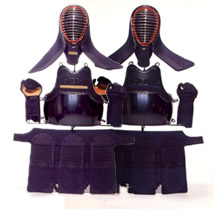
● Traditional Padding
In every Mori Budo-gu’s hand sewn bogu, silk floss and mosen felt are used as its padding.
They make bogu strong enough to endure the hard attacks of shinai, and supple and flexible at the same time. It is a beautiful work of craft inherited and developed in Japan.
Regrettably, the hand-sewn endo-gu on the market now often use the woolen felt similar to the material for the machine-stitch bogu. The reason is that the hand-sewing of silk floss and mosen padding is three times as painstaking as woolen-felt sewing.
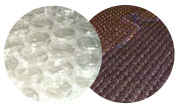 Silk floss saves a lot of air in it to make good cushioning like the packing material "bubble wrap". The soft and protecting nature of silk floss and mosen have contributed to the comfortable usability of our hand-sewn bogu.
Silk floss saves a lot of air in it to make good cushioning like the packing material "bubble wrap". The soft and protecting nature of silk floss and mosen have contributed to the comfortable usability of our hand-sewn bogu.
cElaborate Sewing Method
We do not use the method of naga-sashi (long-thread, or usual stitch) which leaves the thread seen on the back of futon. If the back-face stitching thread is long, the thread gets loose at the top inside the men, and at the shoulder where the menbuton is bent outward, the back thread will hamper the bend.
In our method, tsume-sashi (nail stitch), every stitching point is pressured by two finger nails and sewn tight, leaving only fine weave spots on the backside of futon.
Try feel our menbuton at right angle to the stitching direction. The threads are sunk and won't touch even when the cloth touches your skin. This method makes the sewing thread free from abrasion. So the thread endures a long period of use, and plays its proper role to make a good protector.
● "Ouzan"
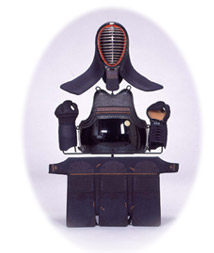
In our highest grade hand-sewn bogu "Ouzan", real mosen (antique scarlet carpet) is used as its padding.
The antique scarlet mosen is a special material picked up from the tangle of coarse fibers whose cellulose of goat or sheep hair with the resin component vanished in the usage in several decades.
This mosen is wrapped in silk floss and sewn into "Ouzan".
Because of its characteristic uneven thickness, this work is far more difficult than the hand sewing of newly produced, felt-type scarlet mosen.
Our well-selected mosen is mainly the material from the Meiji era (1868-1912). Also we stick to the quality of buckskin (deerskin). We use fumigated brown buckskin, or fumigated indigo-dyed buckskin from chibi-kogara (small-built adult deer).
● Mosen

Mosen is a luxurious carpet of fabric originated in China in a distant past, which is made from the hair of animals such as sheep, goat, camel, etc., woven with the moisture, proper temperature, compression and friction. Most of them are dyed deep red and called "scarlet mosen", but there are also indigo-dyed and flower-print mosen.
Antique scarlet mosen,lit from the back.
The combination of old mosen and silk floss has long been used to make bogu light and supple. Its shock-absorption, pleasant feel and durability are unrivaled. However it is becoming more and more difficult to obtain this mosen of antiquity.
● Deerskin
Deerskin has the finest texture in all animal-skin materials.The microscopic texture runs in every direction, and makes extraordinary condition to keep moisture and hygroscopicity, to be free from slimy feels unlike the artificial leather.
Deerskin called "Kogara" from a small-sized adult deer is an ideal material having beautiful and very fine texture. We use even smaller and finer "Chibi Kogara" which is hard to handle, and is ceased to be imported now but still in our stock.
Our deerskins are not chemically dyed.
The brown deerskin is fumigated white deerskin. The smoke and oil of burned straws permeate the skin, and make it durable against the sweat and sebum, adding an elegant tint on it.
"Ibushi-kon-gawa" is the indigo-dyed fumigated deerskin. The natural plant indigo is alkaline, to which the deerskin is vulnerable, so the acidification of fumigation works well to keep its strength. This method has been less and less practiced, but we still keep it for "Ouzan" brand hand-sewn kendo-gu.
●Innovative Technique

We have adopted a new deodorized fiber of Toray Industries into kendo protectors for the first time in the world.
We also use Toray's antibacterial fiber in the stiffeners to double the effect.
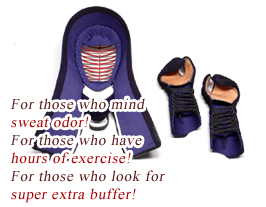
An epoch-making deodorized textile "Kosumeru" is used on the parts against the skin, and the antimicrobial fiber "Seberisu" is included in the inner ring and futon cushion.
This equipment is also highly hygroscopic and resilient, so a fresh feeling continues.

Comfortable and secure gripping of shinai
Dense stuffing of deer fur will protect your hands from strong attacks of shinai.
It is easy to make kote flexible just by reducing the amount of padding. But that kind of kote will make your hands hurt and cannot be called a protector. A hand works in a very complex movement, using its various bones.
Our pursuit for the kote with sufficient padding for a hand protection, without hampering its movement, has resulted in "Rakuken".
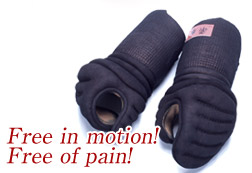
●Deer Fur Padding
Although synthetic fill is commonly used these days, Mori Budo-gu uses deer fur in all of our kote heads. Deer fur has straw-like structure which contains air inside, and that makes good cushioning against the attacks of shinai. It also has suppleness easily to fit hands. So this is the optimum material for kote padding. The usage of deer fur is Japanese heritage and the wisdom of our forerunners. However this material costs and requires proficient skill to work on it.
Handmade Shinai
Shinai, bamboo swords, are made mostly of Taiwanese bamboo called “Keichiku”, and Japanese bamboo “Madake”. Keichiku is used for all levels of swords. The material is stout and flexible, but the fiber is rough and tends to get crack, so the Keichiku shinai needs the condition check especially before exercise.
Madake has fine fiber and has enough flexibility, however due to the reduced production, it is now quite expensive.
Most swords now are machine made, but several craftsmen are still making the swords by shaving the bamboo with traditional hand-plane, with the heat of burnt charcoal to bend the material.
This traditional work may be extinct in the near future, and we are worried about that.
